The Chesapeake and Delaware Canal connects the Chesapeake Bay to the Delaware River. Before this Canal, water transport from Philadelphia to Baltimore had to traverse the Delaware Peninsula. Luckily, this shortcut saves almost 300 miles for travelers. This Canal is often called the C & D Canal and was finished in 1829. Additionally, it is the sole 19th-century American Canal that is still used as a major shipping route.
When constructed, it was initially used as a private enterprise. However, it is now owned by the United States government. Also, it is maintained by the Army Corp of Engineers and is known as the back door to Baltimore. The Chesapeake and Delaware Canal is estimated to carry 40 percent of the cargo out of and into the Port of Baltimore.
How Deep and Wide is the Chesapeake and Delaware Canal?

The Chesapeake and Delaware Canal is 14 miles long. Additionally, it is 35 feet deep and 450 feet wide.
©Grandbrothers/iStock via Getty Images
The Chesapeake and Delaware Canal is 14 miles long. Additionally, it is 35 feet deep and 450 feet wide. This Canal connects the Chesapeake Bay with the Delaware River, and you will find yourself crossing this Canal when traveling the Delaware Bayshore Byway via the Reedy Point Bridge south of Delaware City.
History of the Chesapeake and Delaware Canal
The idea for the Chesapeake and Delaware Canal came about in 1659. A surveyor named Augustine Herman traveled the Delaware River to diffuse a dispute between English and Dutch landowners. Therefore, he needed to cross the land to reach the Chesapeake Bay. Augustine made his crossing at the northern neck of the Delaware Peninsula. As he worked for Cevil Calvert, the second Lord Baltimore, he asked to be paid with the 5000-acre piece of land he had just traveled to reach St. Mary’s City.
His wish was granted, as Lord Baltimore was trying to develop the area. Then, he named the area in honor of his homeland, Bohemia River. When he was done exploring the area, he suggested a Canal to shorten the journey from the Delaware River to the Chesapeake Bay.
What Animals Live in the Chesapeake and Delaware Canal?
The Chesapeake Bay is the biggest estuary in the United States and is full of a variety of wildlife. It runs from the mouth of the Susquehanna River to the Atlantic Ocean and is one of the most productive estuaries worldwide. There are more than 3,600 species of plants and animals calling it home. In addition, it is an essential habitat for wildlife and fishery. The Canal also offers recreational activities for people. We will look at a few animals that live in the Chesapeake and Delaware Canal.
Pied-billed Grebe
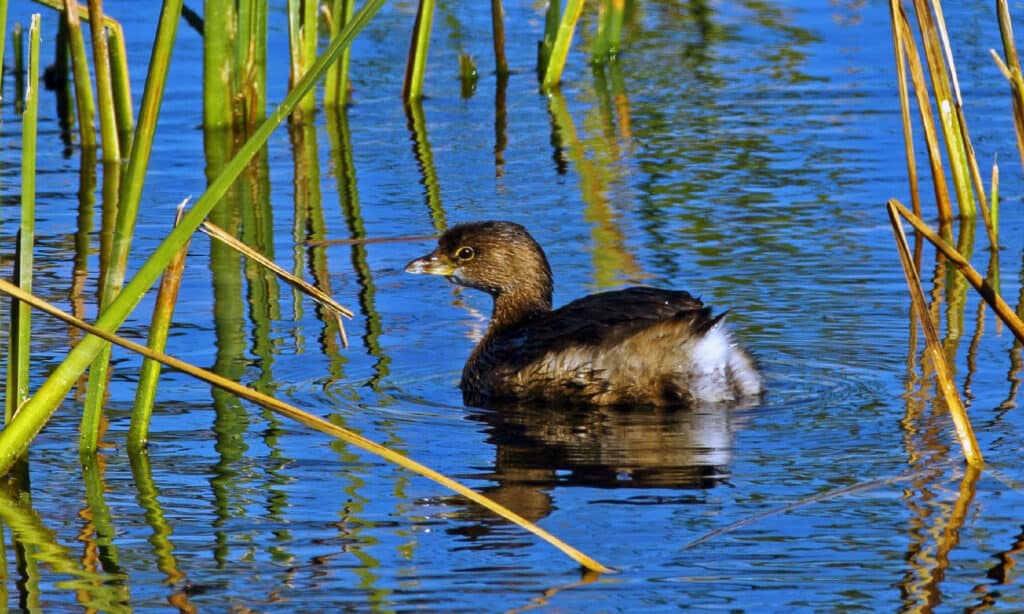
The Pied-pilled grebe eats a variety of fish, insects, and amphibians, such as eels,
catfish
, ants, dragonflies, and tadpoles.
©iStock.com/photographybyJHWilliams
This bird is part of the grebe family and is a water bird. They breed across Canada and parts of the United States. The Pied-billed grebe is not considered a strong flier. However, it has been spotted in Europe and England. It is the most widespread of the North American grebes and occurs on marshes, slow streams, and remote ponds. Also, it is the last to leave northern inland waters in autumn and the first to arrive in the spring. These birds are not known to fly away from prey. Instead, they prefer to escape by diving under the water. The Pied-pilled grebe eats a variety of fish, insects, and amphibians, such as eels, catfish, ants, dragonflies, and tadpoles.
They are smallish birds at 12 to 15 inches in length. However, they are stocky and short-necked. Also, they are the only grebes that do not have a visible white wing patch when they fly. They are not noisy birds, except when the males make themselves heard in the breeding season. Some folk names for this bird include devil-diver, water-witch, dive-dapper, and dabchick.
Great Blue Heron
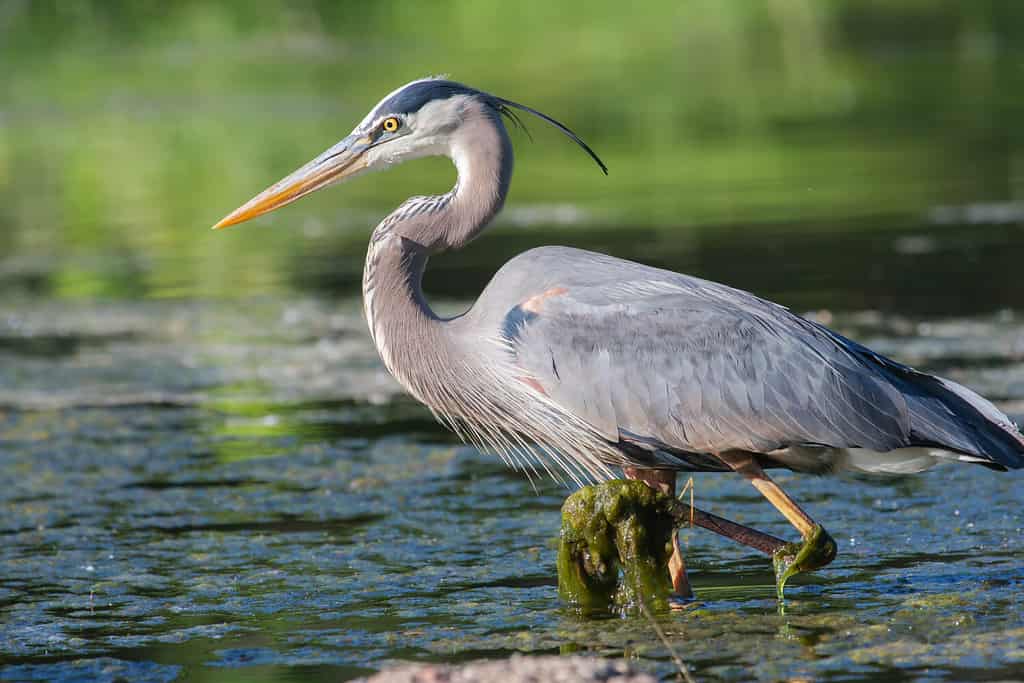
The
Great Blue Heron
is a wading bird that feeds while walking and standing in shallow water. These birds occur worldwide but favor warm regions.
©Joseph Scott Photography/Shutterstock.com
These long-legged birds occur in swamps, marshes, and ponds. However, they can also live along streams, freshwater lakes, and the coast. The Great Blue Heron is a wading bird that feeds while walking and standing in shallow water. These birds occur worldwide but favor warm regions. There are many species of Heron. Some of them are called egrets. Also, they are related to ibises, flamingos, and storks. These birds are tall with long necks and broad wings. The biggest Heron is the Goliath Heron. Compared to them, the Great Blue Heron is slightly smaller. These birds feed during the day and stand still in the water until they see a frog, fish, or small water animal, which they will jab with their bill.
Black Vulture

The Black Vulture is a medium-sized bird with a black tail and white legs. Also, it is dark and has a gray featherless head. These birds can grow between 23 and 28 inches, with a wingspan of about 60 inches.
The Black Vulture is a medium-sized bird with a black tail and white legs. Also, it is dark and has a gray featherless head. These birds can grow between 23 and 28 inches, with a wingspan of about 60 inches. Additionally, they can weigh up to 5 pounds. They eat mostly carrion, but they sometimes also eat small reptiles, mammals, and birds. They can live up to 25 years in the wild and can be found in many countries, including the United States, Argentina, Canada, Mexico, and more. Breeding will take place in dense woodlands. However, they forage in open habitats. In addition, the Black Vulture population is large, with over 10,000.
Carolina Chickadee
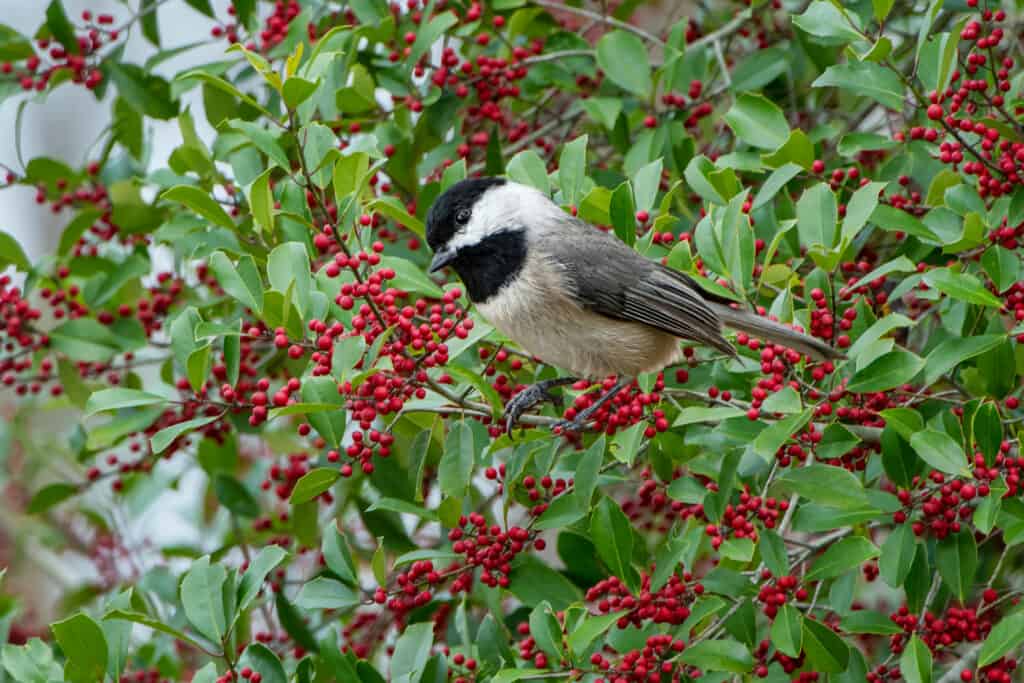
The Carolina
Chickadee
has a long tail and short wings. They are similar to the Black-capped Chickadee. These birds breed in the United States from New Jersey to Texas.
©Bonnie Taylor Barry/Shutterstock.com
These small songbirds found in North America have gray backs, rusty brown underparts, and brown flanks. The Carolina Chickadee has a long tail and short wings. They are similar to the Black-capped Chickadee. These birds breed in the United States from New Jersey to Texas. In addition, they do not migrate even in bad winter weather. These pretty birds are found in shrublands, wetlands, or urban or suburban areas.
Bald Eagle

Interestingly, the female Bald Eagle is bigger than the male. Females can be as long as 3.5 feet, while males can reach 3 feet long. However, females and males look the same.
©PHOTOOBJECT/Shutterstock.com
The national bird of the United States has a dark brown body and white head feathers. As its name states, the white head feathers give it a bald look. Interestingly, the female Bald Eagle is bigger than the male. Females can be as long as 3.5 feet, while males can reach 3 feet long. However, females and males look the same.
Loggerhead
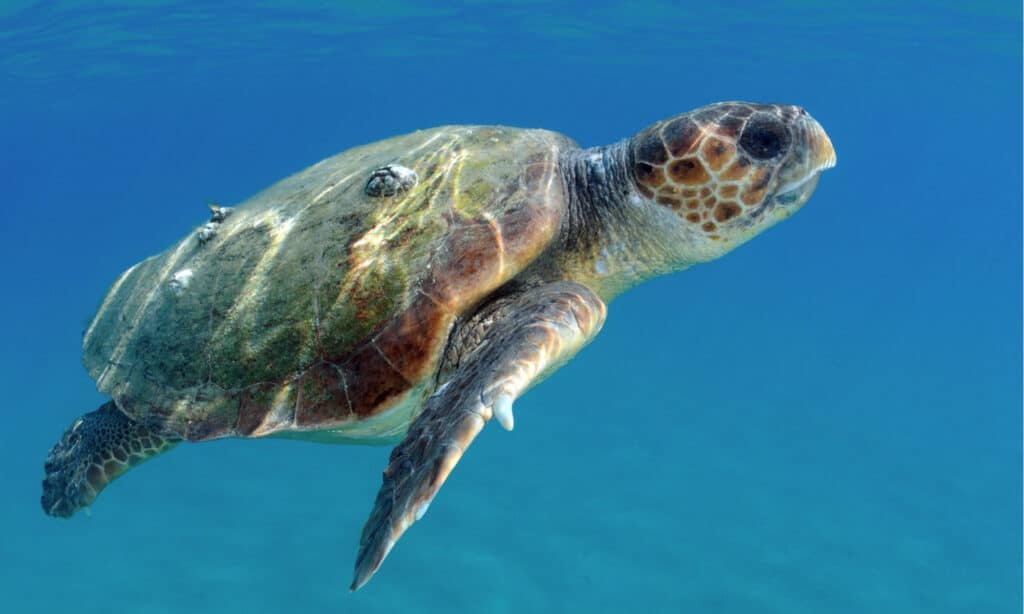
The largest Loggerhead recorded weighed more than a whopping 1,200 pounds. Also, these turtles have especially big heads.
©Matteo photos/Shutterstock.com
This sea turtle is the most common worldwide and can be found all over. However, although the Loggerheads can be found all over, they are still considered endangered. They are one of the seven turtle species found and can weigh up to 298 pounds. The largest Loggerhead recorded weighed more than a whopping 1,200 pounds. Also, these turtles have especially big heads. The Loggerhead is the only turtle with five side scutes and five central scutes, and they live in subtropical and tropical oceans worldwide. Usually, they spend a lot of their time in shallow waters. However, they spend long periods in the open ocean when they migrate. In addition, they are loners and will swim thousands of miles to return to where they were born to mate. Being an omnivore, a Loggerhead will eat things like:
Leatherback
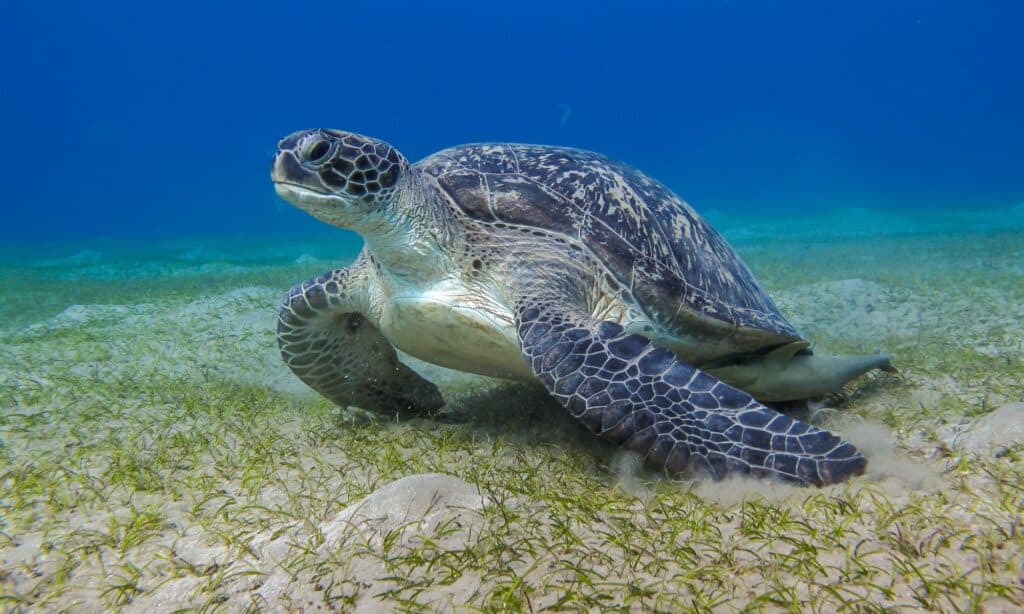
The Leatherback turtle is the biggest living turtle in the world. A mature Leatherback can weigh up to 1 ton. These gentle giants occur in the Caribbean, Mediterranean, Indian, Pacific, and Atlantic oceans.
©iStock.com/YasserBadr_Beenthere
The Leatherback turtle is the biggest living turtle in the world. A mature Leatherback can weigh up to 1 ton. These gentle giants occur in the Caribbean, Mediterranean, Indian, Pacific, and Atlantic oceans. Also, they tend to live in deep waters, not close to the shore. Their names come from the harsh, leathery skin that makes up their shells. This skin is black or dark gray and has white spots. Interestingly, the shell is streamlined to help them swim through water, and they have two front flippers and webbed back feet. Leatherbacks breathe air but can spend long periods underwater while they eat soft animals or jellyfish.
Then, females will travel long distances to lay eggs on warm beaches and typically return to where they hatched. She will make a hole in the sand to lay her many eggs, and then she goes back into the sea. When the eggs hatch, the tiny turtles will start trying to reach the water. However, many of them will not make it. These magical turtles are endangered, and many continue to be accidentally caught in fishing nets.
Thank you for reading! Have some feedback for us? Contact the AZ Animals editorial team.








